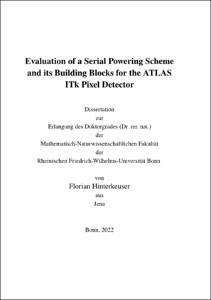Evaluation of a Serial Powering Scheme and its Building Blocks for the ATLAS ITk Pixel Detector

Evaluation of a Serial Powering Scheme and its Building Blocks for the ATLAS ITk Pixel Detector

| dc.contributor.advisor | Desch, Klaus | |
| dc.contributor.author | Hinterkeuser, Florian | |
| dc.date.accessioned | 2022-11-02T16:17:10Z | |
| dc.date.available | 2022-11-02T16:17:10Z | |
| dc.date.issued | 02.11.2022 | |
| dc.identifier.uri | https://hdl.handle.net/20.500.11811/10392 | |
| dc.description.abstract | The high luminosity upgrade for the Large Hadron Collider (LHC) at CERN requires a complete redesign of the current inner detectors of ATLAS and CMS. These new inner detectors will consist of all-silicon tracking detectors, combining multiple layers of silicon hybrid pixel modules and strip detectors. In the new pixel detectors conservative powering schemes are not feasible anymore. Instead serial powering has been chosen as a baseline powering scheme for both the future ATLAS and CMS pixel detectors. In serial powering, multiple detector modules are powered by a constant supply current. This new powering scheme provides challenges for the electrical and mechanical design, from the readout chip to system level considerations.
The main building block of the serial powering scheme foreseen for the ATLAS ITk pixel detector is the shunt low dropout voltage regulator (Shunt-LDO). The Shunt-LDO generates the local supply voltages for each pixel module from the constant supply current while shunting any excess current not drawn by the readout chips. In this thesis the Shunt-LDO is extensively characterised and evaluated. The expanding feature set of the Shunt-LDO has been verified over several years of development and the radiation hardness of the regulator design in the 65 nm CMOS process node used for the ATLAS ITk pixel readout chips has been proven. The operation and performance of next-generation pixel readout chips using the Shunt-LDO was demonstrated using RD53A, a technology demonstrator for the future ATLAS and CMS pixel readout chips. An additional focus of this work is the large scale prototyping of serial powering. In the context of this work the Outer Barrel Demonstrator (OBD) program at CERN was commissioned and yielded first valuable experiences in operating a serially powered pixel detector with representative services and local supports. The OBD was the first prototype to operate multiple parallel, electrically coupled serial powering chains successfully. Finally a serial powering chain with pixel detector modules based on the next-generation readout chip, the RD53A, has been scoped, designed and set up in the context of this thesis with the goal to study low-level properties of serially powered detectors. This prototype, consisting of 8 RD53A quad chip modules with planar silicon sensors, demonstrated the ability to operate a serial powering chain with modules based on the next-generation readout chips without any performance deterioration. | en |
| dc.language.iso | eng | |
| dc.rights | In Copyright | |
| dc.rights.uri | http://rightsstatements.org/vocab/InC/1.0/ | |
| dc.subject | Pixeldetektoren | |
| dc.subject | ATLAS | |
| dc.subject | strahlenharte Detektoren | |
| dc.subject | Pixel detectors | |
| dc.subject | radiation hard detectors | |
| dc.subject.ddc | 530 Physik | |
| dc.title | Evaluation of a Serial Powering Scheme and its Building Blocks for the ATLAS ITk Pixel Detector | |
| dc.type | Dissertation oder Habilitation | |
| dc.publisher.name | Universitäts- und Landesbibliothek Bonn | |
| dc.publisher.location | Bonn | |
| dc.rights.accessRights | openAccess | |
| dc.identifier.urn | https://nbn-resolving.org/urn:nbn:de:hbz:5-68517 | |
| ulbbn.pubtype | Erstveröffentlichung | |
| ulbbnediss.affiliation.name | Rheinische Friedrich-Wilhelms-Universität Bonn | |
| ulbbnediss.affiliation.location | Bonn | |
| ulbbnediss.thesis.level | Dissertation | |
| ulbbnediss.dissID | 6851 | |
| ulbbnediss.date.accepted | 23.09.2022 | |
| ulbbnediss.institute | Mathematisch-Naturwissenschaftliche Fakultät : Fachgruppe Physik/Astronomie / Physikalisches Institut (PI) | |
| ulbbnediss.fakultaet | Mathematisch-Naturwissenschaftliche Fakultät | |
| dc.contributor.coReferee | Dingfelder, Jochen | |
| ulbbnediss.contributor.orcid | https://orcid.org/0000-0002-0556-189X | |
| ulbbnediss.contributor.gnd | 1279525428 |
Files in this item
This item appears in the following Collection(s)
-
E-Dissertationen (4397)




